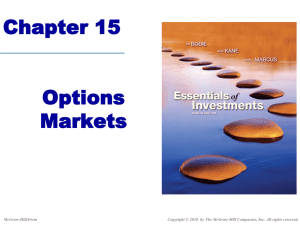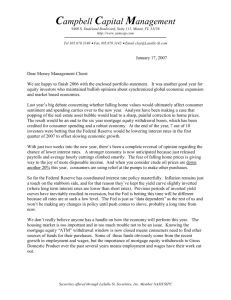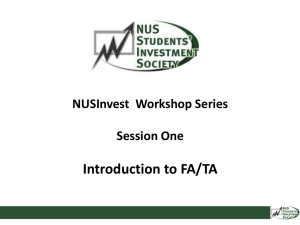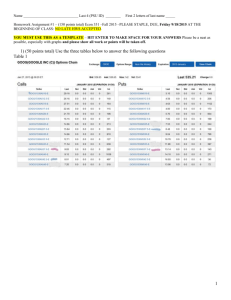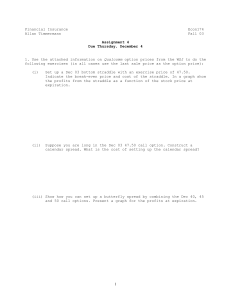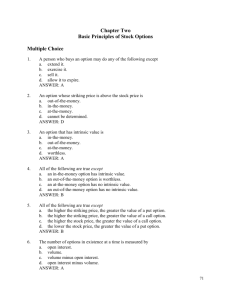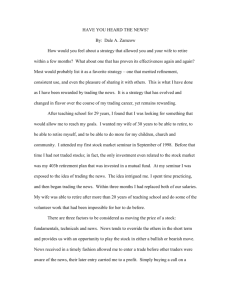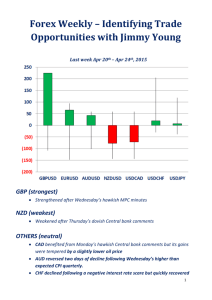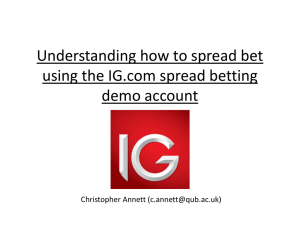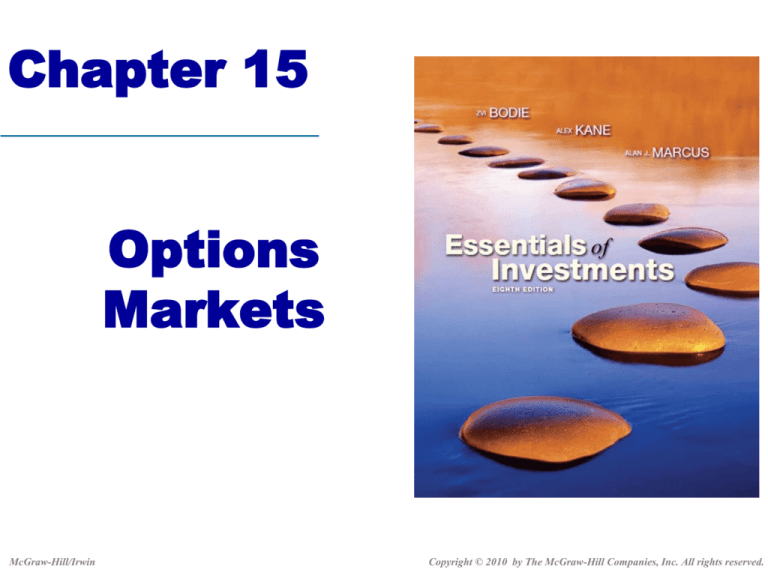
Chapter 15
Options
Markets
McGraw-Hill/Irwin
Copyright © 2010 by The McGraw-Hill Companies, Inc. All rights reserved.
Option Terminology
1. What is a listed stock call option?
– A contract giving the holder the right to buy 100 shares of stock at a
preset price called the exercise or strike price.
– Expirations of 1,2,3,6,& 9 months and sometimes 1 year are normal
contract periods. Contracts expire on the third Saturday of the
expiration month.
– Contracts may be resold prior to maturity.
– Listed => traded on the exchanges (e.g., CBOE). OTC options market
is larger then exchanges
– Rain check: a real life call option example
2. What is a listed stock put option?
- A contract giving the holder the right to sell 100 shares of stock at
a preset price
- Ray Lewis contract with Ravens: a real life example of a put option
- Farmers interested in put options as they are concerned about low crop
prices.
15-2
Option Characteristics
• If a call option holder wishes to purchase the stock using options, he
or she will exercise the option. The option holder must pay the
exercise price to the option writer.
• Exercise prices are adjusted for stock splits and stock dividends, but
not cash dividends.
• The cost of an option is called the premium and it is a small
percentage of the cost of the underlying asset. The option buyer
pays the cost; the option writer receives the cost at the time of sale of
the option.
• Options are a zero sum game.
15-3
American vs. European Options
American: the option can be exercised any time, but no
Later than the expiration date
European: the option can only be exercised at the
expiration date
15-4
Figure 15.1 Options on IBM
15-5
3. Uses of options:
a. To hedge changes in stock price.
b. Change your risk and return profile
• For example, buying a call is analogous to buying
stock on margin.
c. Options give two prices (either to pay for a
call or to get paid for a put) to the holder to
choose from, the market price and the
exercise price. The holder is free to compare
and choose the one which is more favorable!
d. Seller (writer) has only obligations as the
holder makes a decision whether to exercise
(use) it or not..
15-6
Option Clearing Corporation
(OCC)
• OCC is jointly owned by option exchanges
• OCC backs performance of both counterparties
– To limit OCC’s risk, option seller (or writer) must post margin.
Margin varies with option price and whether the option position is
covered or exposed.
• When an option is exercised an option seller is randomly
selected.
– If a call is exercised the selected call writer must deliver 100
shares of stock in exchange for receiving the strike price.
– If a put is exercised the selected put writer must purchase 100
shares of stock at the strike price.
15-7
4. Types of options
Listed Options vs OTC Options
o
o
o
o
o
Index Options
Options on Futures
Foreign Currency Options
Interest Rate Options
Exotic Options
15-8
5. Symbols & Valuation
Ct = Price paid for a call option at time t. t = 0 is today,
T = option's expiration date.
Pt = Price paid for a put option at time t.
St = Stock price at time t.
Xc, Xp= Exercise or Strike Price for a call, or a put
In the money=> profitable to exercise, Out of the money =>?
> Xc.
A call is “in the money” if St ____
A call is “out of the money” if St ____ Xc.
A put is “in the money” if St ____ Xp.
> Xp.
A put is “out of the money” if St ____
>
>
15-9
6. The basics of option pricing
a) Price boundaries
o Ct ≥ 0,
Why?
o Ct ≥ St – X, Why?
o Pt 0
o Pt X - St
$5 $60 $50
– If Ct < St – X How could you take advantage of this?
o Thus Ct Max (0, St – X)
o Pt Max (0, X – St)
15-10
7. Option strategies and profits at expiration
BUYING A CALL
Profit Table
ST < X
ST > X
– C0
– C0
– C0
+CT
0
ST – X
= Profit
– C0
– C 0 + ST – X
Breakeven
ST = X + C 0
15-11
Call profit at expiration (fig 15.1)
Profit
ST = X + C 0
$92.65
$0
-$735
$100
$107.35
-C0 + ST – X
-C0
Ex = $100
Stock
PriceT
IBM Jul 100 call option
Stock Price = $96.14
Exercise = $100
Call premium = $735=$7.35*100
Contract Size 100 shares
Bullish or bearish? Bullish
High or low volatility strategy? High
15-12
Writing a naked call
WRITING A NAKED CALL
Profit Table
ST < X
ST > X
+C0
+C0
+C0
– CT
0
–(ST – X)
= Profit
+C0
+C0 – ST + X
Breakeven
ST = X + C 0
15-13
Writing a naked call
Profit
+C0 – ST + X
+C0
$0
X
S T = X + C0
Stock
PriceT
Bullish or bearish? Bearish
High or low volatility strategy? Low
15-14
Buying a put option
BUYING A PUT
Profit Table
ST < X
ST > X
– P0
– P0
– P0
+PT
X – ST
0
= Profit
X – ST – P0
– P0
Breakeven
ST = X – P0
15-15
Buying a put option (fig 15.1)
Profit
IBM Dec 100 put option
Stock price = $96.14
Exercise = $100
Put premium = $1,166=$11.66*100
Contract Size 100 shares
$8,834
$0
-$1,166
X – ST – P0
$100
$88.34
B.E.: ST = X – P0
$111.66
– P0
Ex = $100
Stock
Pricet
Put
Bullish or bearish? Bearish
High or low volatility strategy? High
15-16
Writing a put option
Writing A Put
Profit Table
ST < X
ST > X
+P0
+P0
+P0
– PT
–(X – ST )
0
= Profit
ST – X + P 0
+P0
Breakeven
ST = X – P0
15-17
Profit
Writing a put option
$1,166
ST – X + P0
$0
$88.34
$100
$111.66
+P0
Stock
Pricet
Xx = $100
- $8,834
Bullish or bearish? Bullish
High or low volatility strategy? Low
15-18
Buy stocks and at the money puts:
Profit
Protective Put Long position
in IBM ($X
borrowed)
Hedged
Position
$0
Stock
Pricet
X
Put
Hedged profit equals sum of profits of put and stock
at each stock price.
15-19
Writing Covered Calls
Profit
Long position
in IBM $X
borrowed
Covered Call
Written call
$0
X
ST = S0 - C0
Stock
Pricet
• Bullish or bearish? Bullish
• High or low volatility strategy? Low
15-20
Bullish Price Spread
Bull perpendicular or bull price spread with
calls; write (sell) the high exercise price
call and buy the low exercise price call. All
other option terms identical. L=low
exercise price, H=high exercise price
15-21
Bullish Price Spread
BULLISH PRICE SPREAD
Profit Table
ST < X L
XL < S T < X H
ST > X H
– C0L
– C0L
– C0L
– C0L
+C0H
+C0H
+C0H
+C0H
+CTL
0
ST – X L
ST – XL
– CTH
0
0
–(ST – XH )
= Profit
C0H – C0L
ST – XL – C0L +C0H
XH – XL – C0L + C0H
Breakeven
–
ST = XL + C0L – C0H
+
Profit
XH
XL
Stock
Pricet
• Bullish or bearish? Bullish
• High or low volatility strategy?
neutral
15-22
Straddle
(Bull or Long) Straddle: buy a put and a call
with the same T and X.
(For bear or short straddle, sell both put and
call and just flip the graph upside down.)
15-23
Straddle
STRADDLE
Profit Table
ST < X
ST > X
– C0
– C0
– C0
– P0
– P0
– P0
+CT
0
ST – X
+PT
X – ST
0
= Profit
X – ST – C0 – P0
ST – X – C0 – P0
Breakeven
ST = X – C0 – P0
ST = X + C 0 + P 0
Profit
$0
X – C0 – P0
X
Max Loss: C0 + P0
X + C0 + P0
Stock
Price t
• Bullish or bearish? _______
Neutral
• High or low volatility strategy? Very
High
15-24
Strips and Straps
•
•
Long or bull strap; buy two calls and one
put, more bullish than straddle.
Long or bull strip; buy two puts and one
call, more bearish than straddle.
Think about bear versions of each.
15-25
8. Warnings about options positions
o Options may have to move 10-15% or more in a short
time period before an investor recovers the premium and
commission.
o Options are by definition short term instruments (with
expiration dates); an investor can ride out bad times in
stock markets but not in options.
– The limited loss feature makes options appear safer than they
are. But you may lose everything you invested.
– You have to compare equal $ investments in stocks and options
to really see the higher risk of the option position.
15-26
.
Profit
What’s wrong with selling options?
o Covered calls (writing calls against stock you own)
Stock
Pricet
$0
– The investor never gets the occasional
large stock price run up and suffers most of the
loss of a big price drop.
Eliminates any positive skewness of stock returns
– Wind up with portfolio of poorer performers
o Naked calls (writing calls when you do not own the
stock)
– Maximum gain is limited to call premium but
unlimited loss, poor strategy in volatile markets
Profit
$0
Stock
Pricet
15-27
Optionlike Securities
1. Callable bonds
– Issuing firm has the right to call in the bond
and pay call price.
– When will the firm want to exercise its call
option? ~ when the interest rate gets low as
this is like a refinancing
15-28
Figure 15.11 Values of Callable Bonds
Compared with Straight Bonds
15-29
2. Convertible Securities
• Security holder has the option to convert the
bond to a fixed number of shares of common
stock.
• If a bond is convertible to 20 shares of stock, stock is
priced at $60 per share. The bond’s conversion value
= $1,200
15-30
Figure 15.12 Value of a Convertible
Bond as a Function of Stock Price
15-31
3. Warrants
– Call options issued by the firm itself allowing
bond investors to purchase new stock shares
in the future at a fixed price.
– Detachable “sweetener” to help sell the bond
– Exercise of warrants (and convertibles) can
result in dilution of earnings per share
15-32
4. Collateralized loans
–
The borrower has an option to repay the loan at maturity if
L > ST, otherwise the borrower can default and give up the
value of L. Your home loan is an option!
5. A similar logic can be applied to corporate equity if
a firm has debt.
–
Equity holders effectively have a call option on firm value
as they can choose to pay off the debt if firm value > value
of the debt or default otherwise. Why is this happening?
Limited liability!
15-33
Exotic Options
Asian Options
Payoff depends on the average (rather than the
final) price of the underlying asset during a
portion of the life of the option.
Barrier Options
Example “down-and-out” expires worthless if
the stock price drops below a specified barrier.
Lookback Options Payoff depends on minimum or max price
during life of option.
15-34
Exotic Options
Currency Translated Options or Quantos
Allows a variable amount of foreign currency
based on the performance of an investment to
be translated to dollars at a fixed exchange rate.
Binary or Digital Options
Pays a fixed amount if the option is in the money at
expiration.
15-35
Problem 1
a.
Purchase a straddle, i.e., buy both a put and a call on
the stock.
The total cost of the straddle would be: $10 + $7 = $17
$17
b.
15-36

